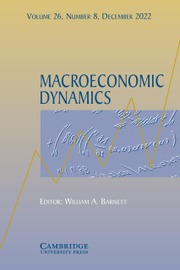Article contents
ASYMMETRY AND THE AMPLITUDE OF BUSINESS CYCLE FLUCTUATIONS: A QUANTITATIVE INVESTIGATION OF THE ROLE OF FINANCIAL FRICTIONS
Published online by Cambridge University Press: 30 August 2016
Abstract
We examine the quantitative significance of financial frictions that reduce firms' access to credit in explaining asymmetric business cycles characterized by disproportionately severe downturns. Using rate spread data to calibrate the severity of these frictions, we successfully match several key features of U.S. data. Specifically, although output and consumption are relatively symmetric (with output being slightly more asymmetric), investment and hours worked display significant asymmetry over the business cycle. We also demonstrate that our financial frictions are capable of significantly amplifying adverse shocks during severe downturns. Although the data suggest that these frictions are only active occasionally, our results indicate that they are still a significant source of macroeconomic volatility over the business cycle.
Keywords
- Type
- Articles
- Information
- Copyright
- Copyright © Cambridge University Press 2016
References
REFERENCES
- 5
- Cited by


